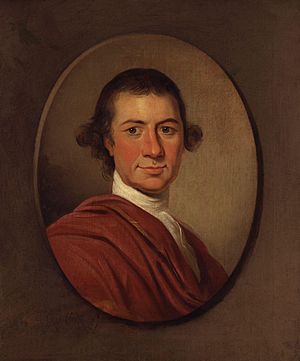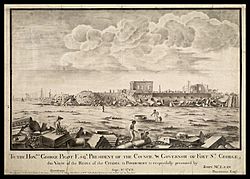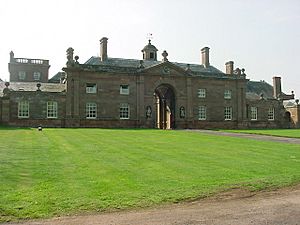George Pigot, 1st Baron Pigot facts for kids
Quick facts for kids
George Pigot
|
|
|---|---|
 |
|
| President of the British East India Company | |
| In office 14 January 1755 – 14 November 1763 |
|
| Preceded by | Thomas Saunders |
| Succeeded by | Robert Palk |
| In office 11 December 1775 – 23 August 1776 |
|
| Preceded by | Alexander Wynch |
| Succeeded by | George Stratton |
| Personal details | |
| Died | 11 May 1777 |
George Pigot, 1st Baron Pigot (4 March 1719 – 11 May 1777) was twice the British President of the British East India Company.
Life
Pigot was the eldest son of Richard Pigot of Westminster, by his wife Frances, daughter of Peter Goode, a Huguenot who had come to England in the late seventeenth century. Frances was a "tirewoman" to Queen Caroline. His brothers were Admiral Hugh Pigot (1722–1792) and Sir Robert.
Pigot entered the service of the East India Company in 1736, at the age of 17; after nineteen years he became governor and commander-in-chief of Madras in 1755. Having defended the city against the French in 1758-1759 and occupied Pondichéry on behalf of the company, he resigned his office in November 1763 and returned to the Kingdom of Great Britain, being made a baronet in 1764. After selling the family seat of Peplow Hall, Shropshire, he purchased Patshull Hall, Staffordshire, in 1765 for £100,000. That year he obtained the seat of Wallingford in the Parliament of Great Britain, which he retained until 1768. In 1766 he was created an Irish peer as Baron Pigot, of Patshull in the County of Dublin. From 1768 until his death he sat in the British House of Commons for Bridgnorth. Pigot was created an LL.D. of the University of Cambridge on 3 July 1769.
Returning to India in 1775 to reoccupy his former position at Madras, Pigot was at once involved in a fierce quarrel with the majority of his council which arose out of the proposed restoration of Thuljaji, the Rajah of Tanjore. The governor was arrested by order of his opponents and was still a prisoner when he died.
Meanwhile, the conduct of Pigot was censured by the court of directors in Great Britain, and the order for his restoration was followed immediately by another for his recall. This happened about a month after his death, but before the news had reached Great Britain. In 1779 the matter was discussed in Parliament, and four of those who were responsible for his arrest were tried and were fined £1000 each. Pigot, who left several illegitimate children, was never married, and his barony became extinct.
Service in the British East India Company

George entered the service of the British East India Company in 1736 as a writer, and arrived at Madras on 26 July 1737. When a member of council at Fort St. David, Pigot was sent with Robert Clive to Trichinopoly in charge of some recruits and stores. On their return with a small escort of sepoys, they were attacked by a large body of polýgars, and narrowly escaped with their lives. Pigot succeeded Thomas Saunders as governor and commander-in-chief of Madras on 14 January 1755. He conducted the defence of the city, when besieged by Thomas-Arthur de Lally in the winter of 1758–9, with considerable skill and spirit. On the capture of Pondichéry by Lieutenant-colonel (afterwards Sir) Eyre Coote (1726–1783) in January 1761, Pigot demanded that it should be given up to the presidency of Madras as the property of the East India Company. This Coote refused after consulting his chief officers, who were of opinion that the place ought to be held for the Crown. Pigot thereupon declared that unless his demand was complied with, he would not furnish any money for the subsistence of the King's troops or the French prisoners. Upon this, Coote gave way, and Pigot took possession of Pondichéry, and destroyed all the fortifications in obedience to the orders previously received from England. Pigot resigned office on 14 November 1763, and forthwith returned to England. He was created a baronet on 5 December 1764, with remainder in default of male issue to his brothers Robert and Hugh, and their heirs male. He represented Wallingford in the British House of Commons from January 1765 to the dissolution in March 1768. At the general election in March 1768, he was returned for Bridgnorth, and continued to sit for that borough until his death. On 18 January 1766, he was created an Irish peer with the title of Baron Pigot, of Patshull in the County of Dublin.
Death
Meantime Pigot died on 11 May 1777, while under confinement at the company's Garden House, near Fort St. George, whither he had been allowed to return for change of air in the previous month. At the inquest held after his death, the jury recorded a verdict of willful murder against all those who had been concerned in Pigot's arrest. The real contest throughout had been between the Nawab of Arcot and the Raja of Tanjore. Members of the council took sides, and Pigot exceeded his powers while endeavouring to carry out the instructions of the directors. The proceedings before the coroner were held to be irregular by the supreme court of judicature in Bengal, and nothing came of the inquiry instituted by the company. On 16 April 1779, Admiral Hugh Pigot brought the subject of his brother's deposition before the House of Commons. A series of resolutions affirming the principal facts of the case was agreed to, and an address to the king, recommending the prosecution of Messrs. Stratton, Brooke, Floyer, and Mackay, who were at that time residing in England, was adopted. They were tried in the King's Bench before Lord Mansfield and a special jury in December 1779, and were found guilty of a misdemeanour in arresting, imprisoning, and deposing Lord Pigot. On being brought up for judgment on 10 February 1780, they were each sentenced to pay a fine of £1,000, on payment of which they were discharged.
Family
Two of the governor's brothers were men of repute. Sir Robert Pigot (1720–1796), who succeeded to the baronetcy, commanded his regiment (the 38th) at the battles of Lexington and Bunker Hill during the American Revolutionary War. He became a lieutenant general in 1782. The other brother, Hugh Pigot (c. 1721–1792) was a sailor. After some years of service he became an admiral and commander-in-chief in the West Indies in 1782. One of his sons was General Sir Henry Pigot (1750–1840), and another was Hugh Pigot (1769–1797), a captain in the RN, who in September 1797, was murdered during a famous mutiny – caused by his own cruelty and brutality – while in command of HMS Hermione.
Pigot was unmarried. Upon his death the Irish barony became extinct, while the baronetcy devolved on his brother Robert Pigot. He left several natural children, among others:
- Sophia Pigot, who married, on 14 March 1776, the Hon. Edward Monckton of Somerford Hall, Staffordshire, and died on 1 January 1834;
- Richard Pigot (1774–1868), general in the army and colonel of the 4th dragoon guards;
- Sir Hugh Pigot, K.C.B. (1775–1857), admiral of the White;
- Leonora, who received a fortune under her father's will and married 17 October 1777 Claude Russell, member of the Madras Council; to the memory of her and her husband there is a tablet in Marylebone Church.
- Major George Pigot (1772?-1830) Along with Richard and Hugh, son of Catherine Hill. Member of settler community who immigrated from England (1820) to present Eastern-Cape coast of South Africa.
- Mary Green (c.1772-1852) who married, aged twelve in 1784, John Blashfield of Presteigne, Radnorshire.
The Pigot Diamond
Pigot owned a celebrated diamond, now known as the Pigot Diamond, which he bequeathed to his siblings and eventually left the family by way of a lottery. The whereabouts of the diamond today is unknown.


